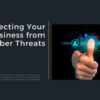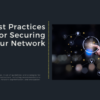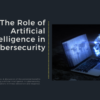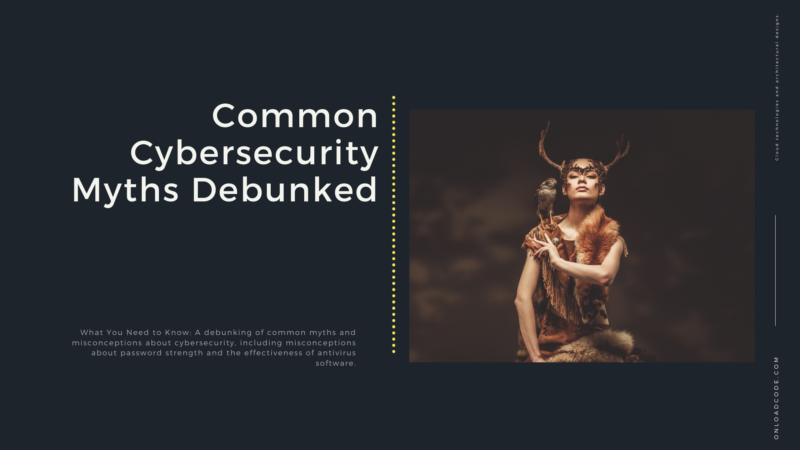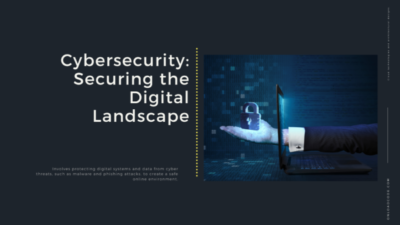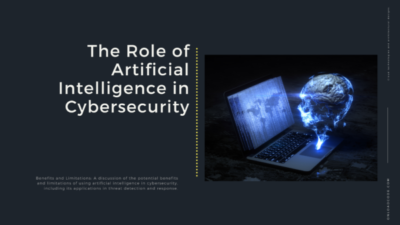A debunking of common myths and misconceptions about cybersecurity, including misconceptions about password strength and the effectiveness of antivirus software.
This is the 7th article in the Cybersecurity: Securing the Digital Landscape series. In this article, we are discussing Common Cybersecurity Myths Debunked.
Introduction to Cybersecurity Myths
In today’s digital age, where cyber threats are becoming increasingly sophisticated, it is essential to separate fact from fiction when it comes to cybersecurity. Unfortunately, there are many misconceptions and myths surrounding the subject that can lead to inadequate protection and increased vulnerability. This article aims to debunk common cybersecurity myths and provide you with the knowledge you need to enhance your security practices.
Cybersecurity myths can be detrimental as they often misguide individuals and organizations in their efforts to safeguard their digital assets. By understanding the reality behind these myths, you can make informed decisions and implement effective cybersecurity measures.
In this section, we will explore the impact of cybersecurity myths and the importance of debunking them. By shedding light on these misconceptions, we can pave the way for a more secure digital environment.
Understanding the Impact of Cybersecurity Myths
Cybersecurity myths can have serious consequences for individuals and businesses. They create a false sense of security and lead to complacency in protecting sensitive information. When people believe in these myths, they may neglect fundamental security practices, leaving themselves vulnerable to cyber attacks.
For example, one common myth is that antivirus software provides complete protection against all threats. While antivirus software is an essential component of cybersecurity, it is not a foolproof solution. Relying solely on antivirus software without implementing additional security measures can leave your system exposed to sophisticated threats such as zero-day exploits and advanced malware.
Importance of Debunking Common Misconceptions
Debunking cybersecurity myths is crucial for promoting a culture of security awareness and proactive risk management. By debunking these myths, individuals, and organizations can adopt a more comprehensive and effective approach to cybersecurity.
For instance, the myth that Mac users are immune to cyber threats can lead Mac users to believe they are safe from attacks and may not take necessary precautions. However, Mac systems are not invulnerable to malware and other cyber threats. Debunking this myth helps Mac users recognize the importance of implementing security measures, such as using reputable antivirus software and practicing safe browsing habits.
By debunking cybersecurity myths, we empower individuals and organizations to make informed decisions and implement robust security measures to protect their digital assets.
In the following sections, we will dive into specific cybersecurity myths and provide accurate information and practical examples to dispel these misconceptions. By understanding the truth behind these myths, you can strengthen your cybersecurity defenses and mitigate the risks posed by cyber threats.
Remember, knowledge is key when it comes to cybersecurity, and debunking these myths is the first step toward building a resilient and secure digital presence.
Myth 1: Antivirus Software Provides Complete Protection
One of the most common cybersecurity myths is that antivirus software alone is sufficient to protect against all types of threats. While antivirus software plays a vital role in detecting and removing known malware, it is not a comprehensive solution on its own.
The reality is that cyber threats are constantly evolving, with new malware variants and attack techniques emerging regularly. Antivirus software relies on signature-based detection, which means it can only identify known threats based on predefined patterns. It may not be able to detect sophisticated, zero-day exploits or malware that uses advanced obfuscation techniques.
To address this myth, it is crucial to emphasize the importance of a layered security approach. Antivirus software should be complemented with other security measures such as:
- Firewall protection: A firewall acts as a barrier between your network and the internet, monitoring and controlling incoming and outgoing traffic. It helps filter out malicious connections and protects against unauthorized access attempts.
- Intrusion Detection and Prevention Systems (IDPS): IDPS solutions monitor network traffic and detect and respond to suspicious activities or potential intrusions. They can identify and block unauthorized access attempts, abnormal network behavior, and known attack patterns.
- Endpoint Protection: Endpoint protection solutions provide advanced threat detection and prevention capabilities on individual devices. They can detect and block malicious activities in real time, protecting endpoints from malware infections and unauthorized access attempts.
By combining these security measures with antivirus software, you create a more robust defense against a wide range of cyber threats.
Myth 2: Strong Passwords Are Enough to Protect Accounts
Another prevalent myth is that using strong passwords is sufficient to protect online accounts from unauthorized access. While strong passwords are important, relying solely on them is not enough to ensure account security.
Cybercriminals employ various techniques, such as brute-force attacks, phishing, and credential stuffing, to compromise accounts. They can bypass even the strongest passwords if other security measures are lacking.
To counter this myth, it is essential to promote the use of multi-factor authentication (MFA). MFA adds an extra layer of security by requiring users to provide additional verification factors, such as a fingerprint scan, a one-time password, or a hardware token, in addition to their password. This significantly reduces the risk of unauthorized access, even if passwords are compromised.
Furthermore, user education on recognizing and avoiding phishing attacks is crucial. Phishing attacks often trick users into revealing their login credentials through deceptive emails, websites, or messages. By educating users about the telltale signs of phishing attempts and encouraging them to verify the legitimacy of communication before providing login information, the risk of account compromise can be minimized.
Myth 3: Small Businesses Are Not Targeted by Cybercriminals
Many small businesses fall victim to the myth that they are not attractive targets for cybercriminals. However, the reality is that small businesses are frequently targeted precisely because they may have weaker security measures in place compared to larger enterprises.
Cybercriminals recognize that small businesses often lack dedicated cybersecurity resources and may not have implemented robust security measures. This makes them an easy target for attacks such as ransomware, phishing, and business email compromise.
To address this myth, it is crucial for small businesses to prioritize cybersecurity and implement appropriate security controls. This includes regularly patching and updating software, training employees on security best practices, and establishing incident response plans.
By dispelling the myth that small businesses are immune to cyber threats, organizations can take proactive steps to protect themselves and their valuable assets.
Myth 4: Using Public Wi-Fi Is Always Risky
There is a widespread belief that connecting to public Wi-Fi networks is always unsafe and puts your sensitive information at risk. While it is true that public Wi-Fi networks can be vulnerable to attacks, not all public networks pose the same level of risk.
The reality is that the security of a public Wi-Fi network depends on various factors, such as the network’s configuration, encryption protocols, and the practices of the network provider. Some establishments, such as cafes, hotels, and airports, may offer secure and encrypted Wi-Fi connections, making them relatively safe for browsing and basic online activities.
However, it is important to remain cautious and take additional precautions when using public Wi-Fi networks. Here are some best practices to follow:
- Connect to trusted networks: Whenever possible, connect to Wi-Fi networks provided by trusted establishments or organizations. These networks are more likely to have implemented security measures to protect users’ data.
- Use a VPN: A Virtual Private Network (VPN) creates an encrypted tunnel between your device and the internet, ensuring that your data remains private and protected. By using a VPN, even when connected to public Wi-Fi, your online activities are shielded from potential eavesdropping.
- Avoid sensitive transactions: Avoid conducting sensitive transactions, such as online banking or shopping, that involve providing credit card information when connected to public Wi-Fi networks. Wait until you have access to a trusted and secure network.
- Keep devices updated: Ensure that your devices, including smartphones, tablets, and laptops, are updated with the latest security patches and firmware updates. This helps protect against known vulnerabilities that cybercriminals may exploit.
By following these practices, you can minimize the risks associated with public Wi-Fi networks and protect your sensitive information from unauthorized access.
Myth 5: Cybersecurity is the Sole Responsibility of IT Departments
Another misconception is that cybersecurity is solely the responsibility of IT departments or security professionals within an organization. In reality, cybersecurity is a shared responsibility that involves every individual within the organization.
While IT departments play a critical role in implementing security measures, monitoring systems, and responding to threats, every employee has a role to play in maintaining a secure environment. Here are some key aspects of shared responsibility:
- Employee awareness and training: All employees should receive cybersecurity awareness training to understand common threats, recognize social engineering tactics, and follow best practices for data protection. This includes identifying phishing emails, using strong passwords, and reporting suspicious activities.
- Compliance with security policies: Employees should adhere to the organization’s security policies and procedures. This includes following guidelines for accessing and handling sensitive data, using authorized software and tools, and reporting security incidents promptly.
- Vigilance and reporting: Every employee should be vigilant and proactive in identifying potential security incidents or vulnerabilities. Encouraging a culture of reporting and providing clear channels for reporting suspicious activities can help detect and mitigate threats in a timely manner.
- Collaboration with IT: Employees should collaborate with the IT department by promptly reporting security concerns, seeking guidance on security-related matters, and actively participating in security initiatives and training programs.
By fostering a culture of shared responsibility, organizations can create a strong defense against cyber threats and reduce the likelihood of successful attacks.
Myth 6: Cybersecurity is Only a Concern for Large Businesses
One prevailing myth is that cybersecurity is only a concern for large corporations or organizations with significant resources and valuable data. In reality, cyber threats can impact businesses of all sizes, including small and medium-sized enterprises (SMEs) and individual entrepreneurs.
Cybercriminals often target smaller businesses precisely because they may have weaker security measures in place. They exploit vulnerabilities such as outdated software, weak passwords, and a lack of employee awareness. It is crucial for businesses of all sizes to prioritize cybersecurity and take appropriate measures to protect their assets and sensitive information.
Here are some steps that businesses, regardless of their size, can take to enhance their cybersecurity posture:
- Conduct a risk assessment: Identify potential threats and vulnerabilities specific to your business. Assess the potential impact of a cyber attack and prioritize areas that require immediate attention.
- Implement robust security measures: Deploy firewall protection, antivirus software, and intrusion detection systems to defend against common threats. Regularly update and patch software and firmware to address security vulnerabilities.
- Enforce strong access controls: Implement strict access controls to ensure that only authorized personnel can access sensitive information or critical systems. Use multi-factor authentication and enforce the principle of least privilege.
- Educate employees: Provide comprehensive cybersecurity awareness training to all employees. Teach them about common threats, safe browsing practices, and how to handle sensitive information securely. Encourage a culture of security consciousness.
- Secure remote work environments: With the increasing prevalence of remote work, ensure that remote employees have secure access to company resources. Use secure VPN connections, provide encrypted communication tools, and establish policies for secure remote access.
- Regularly backup data: Implement a regular backup strategy to ensure critical data is protected in the event of a ransomware attack or data breach. Test the backup and restore process to ensure its effectiveness.
By implementing these practices, businesses can significantly reduce their risk of falling victim to cyber-attacks and minimize the potential impact of security incidents.
Myth 7: Cybersecurity Measures Are Expensive and Complex
There is a common misconception that effective cybersecurity measures are costly and require sophisticated technical expertise. While some advanced security solutions may involve higher costs, there are several cost-effective measures that businesses can adopt to strengthen their defenses.
- Employee training: Investing in cybersecurity awareness training for employees is a cost-effective way to mitigate risks. By educating employees about common threats and best practices, businesses can significantly enhance their overall security posture.
- Strong passwords and multi-factor authentication: Implementing strong password policies and enabling multi-factor authentication (MFA) adds an extra layer of security without significant financial investment.
- Regular software updates and patches: Keeping software and systems up to date with the latest security patches is a crucial practice that helps prevent the exploitation of known vulnerabilities.
- Incident response planning: Developing an incident response plan is an essential aspect of cybersecurity preparedness. It outlines the steps to be taken in the event of a security incident and ensures a timely and coordinated response.
- Security outsourcing: For businesses lacking in-house expertise, outsourcing certain security functions to managed security service providers (MSSPs) can be a cost-effective option. MSSPs offer specialized security services tailored to the specific needs of businesses.
It is important to recognize that cybersecurity is an ongoing process, and no single solution can provide complete protection. By adopting a layered approach and prioritizing key security measures, businesses can strike a balance between cost-effectiveness and effectiveness in protecting their digital assets.
Myth 8: Mac Users Are Immune to Cyber Threats
Contrary to popular belief, Mac users are not immune to cyber threats. While Mac operating systems have historically been less targeted than Windows systems, they are not invulnerable. Cybercriminals have increasingly shifted their focus to Mac platforms due to their growing popularity. Mac users can still fall victim to malware, phishing attacks, and other cyber threats. It is crucial for Mac users to install security software, keep their operating systems and applications up to date, and practice safe browsing and email habits.
Myth 9: Small Businesses Are Not Targeted by Cybercriminals
Many small business owners mistakenly believe that cybercriminals only target large organizations. However, small businesses are prime targets for cyber attacks. In fact, small businesses often lack robust cybersecurity measures, making them vulnerable to breaches. Cybercriminals understand this and specifically target small businesses to exploit weaknesses in their security defenses. Small businesses should prioritize cybersecurity by implementing strong access controls, employee training, regular security assessments, and data backup measures to protect themselves from cyber threats.
Myth 10: Only High-Profile Organizations Are at Risk
It is a common misconception that only high-profile organizations are at risk of cyber attacks. In reality, businesses of all sizes and individuals are susceptible to cyber threats. Cybercriminals target organizations and individuals based on various factors, including the potential for financial gain, access to sensitive data, and even as part of widespread attacks. No organization or individual is immune to cyber risks. Everyone must remain vigilant and implement appropriate cybersecurity measures to mitigate the chances of falling victim to an attack.
Myth 11: I Have Nothing Worth Stealing, So I’m Not a Target
Another prevalent myth is that individuals who believe they have nothing valuable to offer are not at risk of cyber attacks. However, cybercriminals target individuals for various reasons beyond monetary gain. Personal information such as social security numbers, login credentials, or personal photographs can still be exploited for identity theft, blackmail, or other malicious purposes. Additionally, compromised devices can be used as entry points to launch attacks on others. It is crucial for individuals to understand that they are potential targets and take necessary precautions such as using strong and unique passwords, enabling two-factor authentication, and regularly updating their devices and software.
Remember, cybersecurity is important for everyone, regardless of the platform, organization size, or perceived value of information. By dispelling these myths and taking appropriate security measures, individuals and organizations can better protect themselves against cyber threats.
Conclusion
In conclusion, debunking common cybersecurity myths is essential for promoting a more accurate understanding of the threats and challenges businesses face. By dispelling these misconceptions, businesses can make informed decisions, allocate resources effectively, and implement appropriate security measures.
Remember, cybersecurity is a shared responsibility that extends beyond IT departments. It requires a proactive approach, continuous education, and a commitment to staying ahead of evolving threats. By addressing these myths and taking proactive steps, businesses can significantly enhance their cybersecurity posture and protect themselves against a wide range of cyber threats.
My articles on medium

